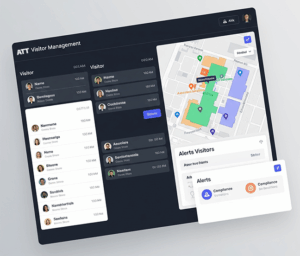
News & Updates

Visitor Systems vs. Manual Check-ins: Security Insights
In 2025, organisations across sectors are rethinking how they manage visitors a critical frontline in safeguarding assets, people, and data. The question of Visitor Management Systems (VMS) vs. traditional check-ins is no longer just about convenience; it’s a matter of compliance, risk mitigation, and operational efficiency. As security threats grow more sophisticated and regulatory standards tighten, forward-thinking businesses in healthcare, government, and finance are seeking solutions that go far beyond paper sign-in sheets. This comprehensive analysis uncovers how modern VMS platforms, such as those offered by ATT™ Group, are reshaping visitor access control for the digital age. We will examine the advanced security features, compliance benefits, and operational gains that set VMS apart from legacy check-in methods empowering organisations to make informed, future-ready choices for secure, efficient visitor management.
Real-Time Identity Verification and Threat Detection
Identity verification is the cornerstone of effective security. In 2025, digital Visitor Management Systems (VMS) have transformed this crucial process, moving well beyond manual check-in books and handwritten visitor badges. Today’s VMS platforms integrate advanced biometric authentication, automated watchlist screening, and AI-driven threat detection, raising the bar for both security and compliance. These capabilities are especially vital for regulated sectors such as healthcare and government where the cost of unauthorised access or missed alerts can be severe. In contrast, traditional check-ins are fundamentally limited: they rely on visual inspections and manual validation, leaving significant gaps that can be exploited by bad actors. The result is a clear divergence in risk profiles between organisations that have adopted digital visitor management and those still reliant on paper- based processes.
For decision-makers, the shift to VMS is not simply about adopting new technology it’s about establishing a robust, data-driven defence against evolving security threats. By automating identity checks and integrating real-time intelligence, VMS solutions empower security teams to act swiftly and decisively. With every visitor interaction digitally recorded and analysed, organisations gain proactive oversight, ensuring that only verified individuals gain access to sensitive areas. This evolution marks a new era in visitor authentication, where data accuracy and instant threat response become the norm, not the exception.
Biometric and Digital ID Authentication
Biometric authentication has become standard practice in modern visitor management. Technologies such as facial recognition and fingerprint scanning, once the domain of pilot projects, are now routinely deployed in VMS platforms across high-security environments. The result is swift, accurate identity verification often completed in seconds. This not only streamlines the visitor experience but also sharply reduces the risk of impersonation or fraudulent access. By contrast, traditional paper-based check- ins rely solely on self-declared information and basic ID checks, which are susceptible to errors and deception. Digital identity verification ensures that every individual entering the premises matches their registered credentials, significantly enhancing organisational security.
Automated Watchlist and Blacklist Integration
A key advantage of digital VMS is the ability to cross-reference visitor details against internal and external watchlists in real time. As soon as a visitor registers, the system automatically screens their information against databases of high-risk individuals, regulatory blacklists, or custom exclusion lists. If a match is found, security teams are instantly alerted enabling swift intervention before access is granted. This level of automated screening is impossible with manual processes, where oversight and delays are common. For sectors like finance and healthcare, where compliance with security directives is non-negotiable, VMS-driven watchlist integration provides a crucial layer of risk prevention and regulatory assurance.
AI-Driven Anomaly Detection
Artificial intelligence now plays a pivotal role in visitor management by detecting unusual patterns that may signal security threats. VMS platforms analyse visitor behaviour such as repeated entry attempts, after-hours access, or movement into restricted zones and flag anomalies in real time. This proactive approach gives security teams the insight needed to intervene before incidents escalate. Manual check-ins, lacking structured data and analytics, simply cannot deliver the same level of vigilance. By embedding AI-driven anomaly detection, organisations not only respond to threats faster but also build a continuous feedback loop for ongoing security improvement.
Data Security, Privacy, and Regulatory Compliance
In 2025, the management of visitor data is under intense regulatory scrutiny, with privacy laws like ISO 27001, PDPA, and GDPR demanding uncompromising standards. Digital VMS platforms have emerged as essential tools for compliance, offering robust encryption, detailed audit trails, and granular access controls. These features ensure that sensitive visitor information is both secure and accessible only to authorised personnel. In contrast, traditional paper logbooks present numerous vulnerabilities: they can be misplaced, viewed by unauthorised individuals, or even tampered with posing significant risks to data privacy and regulatory compliance. For organisations operating in high-compliance sectors, the transition to digital VMS is not just a matter of convenience but a strategic imperative to avoid costly breaches and penalties.
Beyond compliance, digital VMS solutions offer a transparent, auditable record of every visitor interaction. This level of accountability is increasingly required by regulatory bodies conducting audits or investigating incidents. Automated digital records ensure that organisations can demonstrate due diligence and quickly respond to information requests. Manual systems, lacking these capabilities, leave organisations exposed to both operational inefficiencies and regulatory shortfalls. Adopting a VMS is therefore a crucial step for any organisation aiming to uphold best practices in data security and privacy in 2025.
Encrypted Data Storage and Access Controls
Enterprise-grade VMS platforms employ advanced encryption protocols and tiered access rights to safeguard visitor data. Sensitive information is stored securely, often in compliance with internationally recognised standards, and access is strictly limited to authorised staff members. This reduces the risk of both internal misuse and external breaches. Conversely, paper-based logs are typically left exposed at reception areas and can be easily accessed, copied, or lost creating a significant security vulnerability. By leveraging encrypted storage and controlled access, digital VMS platforms ensure that visitor records remain protected throughout their lifecycle.
Audit Trails and Digital Record keeping
One of the standout features of digital VMS is the automated recording of every access event, data modification, and export. These comprehensive audit trails create a tamper-proof log that is invaluable for compliance audits and incident investigations. Regulatory bodies are increasingly mandating such transparency, making digital record keeping an operational necessity. Manual processes, by contrast, offer little in the way of traceability; paper logs can be altered or go missing, complicating efforts to verify access or investigate incidents. With digital VMS, organisations gain the confidence that their visitor data is both accurate and fully traceable, supporting continuous compliance and risk management.
Incident Response and Post-Event Analytics
Effective incident response relies on rapid access to accurate information. In this regard, digital Visitor Management Systems provide a decisive advantage over traditional check-ins. With all visitor interactions digitally recorded and instantly retrievable, security teams can quickly identify who was on site, when, and where. VMS platforms frequently integrate with surveillance systems, enabling a seamless link between visitor records and CCTV footage. This integration accelerates investigations, supports timely intervention, and ensures that evidence is readily available for post-incident review. In contrast, manual logbooks require time-consuming searches and often lack the detail needed for effective response, increasing the risk of delayed or incomplete incident resolution.
Beyond immediate response, digital VMS platforms offer powerful analytics tools to review incidents and refine security protocols. By aggregating visitor data and generating automated reports, organisations can identify patterns, highlight vulnerabilities, and implement targeted improvements. Manual processes simply cannot provide the structured data necessary for such proactive risk management. The result is that organisations relying on digital VMS are better equipped not only to respond to incidents but also to prevent them building a culture of continuous security improvement.
Instant Access to Visitor Logs and Footage
When a security incident arises, time is of the essence. Digital VMS platforms enable security teams to retrieve comprehensive visitor logs within seconds, including precise timestamps, entry points, and, where available, linked CCTV footage. This immediate access is crucial for reconstructing events, identifying individuals involved, and supporting law enforcement or internal investigations. Manual logbooks, on the other hand, require laborious page-by-page searches and often contain incomplete or illegible entries, leading to costly delays and potential gaps in evidence.
Data-Driven Post-Incident Reviews
VMS platforms aggregate visitor data into structured analytics dashboards, providing valuable insights into incident trends and potential vulnerabilities. Automated reporting highlights recurring issues, enabling organisations to adjust security protocols and training accordingly. This data-driven approach to post-incident review supports continuous improvement and proactive risk mitigation. In contrast, manual check-ins lack the data fidelity required for meaningful analysis, making it difficult for organisations to learn from past incidents or demonstrate compliance during audits.
Adaptive Access Control and Integration with Security Ecosystems
Modern security strategies demand adaptive, integrated access control capabilities that digital Visitor Management Systems are uniquely positioned to deliver. VMS platforms now interface seamlessly with electronic locks, access cards, gantries, and surveillance networks, ensuring that visitor permissions are dynamically managed in real time. This interoperability is essential for organisations operating across multiple sites or with complex security requirements. Traditional check-ins, by contrast, are isolated and manual, increasing the likelihood of human error and limiting the ability to respond swiftly to changing circumstances. The move towards integrated security ecosystems reflects the broader industry trend towards smart infrastructure and holistic risk management.
Centralising control through VMS not only enhances security but also streamlines operations. Security managers gain a unified view of all access points and visitor activity, making it easier to enforce policies, identify anomalies, and respond to incidents. The ability to adjust permissions instantly, whether in response to emergencies or evolving risk profiles, delivers a level of agility that manual systems simply cannot match. By embedding VMS at the heart of their security ecosystem, organisations unlock new levels of flexibility, resilience, and compliance crucial in the fast-moving regulatory and threat landscape of 2025.
Seamless Integration with Physical Security Systems
Today’s VMS solutions are designed for direct integration with a wide range of physical security systems, including electronic door locks, gantries, and CCTV networks. This connectivity allows for conditional access such as issuing time-limited visitor passes or restricting movement to specific zones and enables real-time monitoring of entry points. Integration eliminates the need for separate manual workflows, reducing the risk of mistakes and ensuring that access permissions are strictly enforced at all times. Manual check-ins, lacking this integration, are inherently less secure and more resource-intensive.
Dynamic Permission Management
A standout feature of modern VMS platforms is the ability to adjust visitor permissions instantly through a centralised interface. If a security risk is detected or organisational policies change, access can be revoked or modified with a single action minimising the window of vulnerability. This dynamic management is especially valuable during emergencies, when rapid adjustments to access rights can protect people and assets. Traditional check-ins, being static and paper-based, are unable to respond in real time, leaving organisations exposed to evolving threats.
Centralized Security Command and Control
Enterprise-grade VMS platforms provide centralised dashboards that consolidate data from multiple locations and security systems. This unified view equips security managers with holistic oversight, simplifying policy enforcement and incident response. By bringing together visitor records, access events, and surveillance feeds, organisations can coordinate their security posture with unprecedented efficiency. Manual systems, fragmented across different sites and processes, make such strategic management impractical limiting the effectiveness of security teams in complex environments.
User Experience, Operational Efficiency, and Resource Optimization
Visitor management should not come at the cost of convenience or productivity. In fact, the best security solutions enhance user experience while driving operational efficiency. Digital VMS platforms achieve this balance through features like pre-registration, self-service kiosks, and automated notifications reducing bottlenecks, speeding up check-ins, and freeing staff for higher-value tasks. These improvements are particularly significant in high-traffic environments such as hospitals, public service centres, and corporate offices, where delays and paperwork can erode both security and customer satisfaction. Traditional check-ins, reliant on manual entry and physical paperwork, often create queues and administrative burdens that detract from overall efficiency.
Optimising resources is a key outcome of digital visitor management. By automating routine processes and enabling self-service, organisations can deploy staff more strategically, focusing on complex security or customer service needs. The measurable gains in productivity, compliance, and user satisfaction make VMS an essential investment for organisations intent on delivering both robust security and exceptional service in 2025.
Frictionless Visitor Registration and Pre-Arrival Screening
Digital VMS platforms enable visitors to register online in advance, receive QR codes, and complete compliance steps before setting foot on site. On arrival, self-service kiosks and mobile check-ins eliminate queues and paperwork, allowing visitors to proceed smoothly through access points. This not only enhances the user experience but also ensures that security screening is completed efficiently and accurately. Manual sign-in processes, in contrast, are prone to congestion and errors slowing down operations and increasing frustration for both visitors and staff.
Automated Notifications and Staff Workload Reduction
Modern VMS systems automate key tasks such as notifying hosts of visitor arrivals, printing badges, and managing repeat visitor profiles. Real-time alerts and streamlined workflows significantly reduce the workload on reception and security staff, enabling them to focus on more complex responsibilities. This automation not only lowers operational costs but also minimises the risk of errors or missed alerts. Manual processes, with their reliance on human intervention at every stage, are inherently less efficient and more susceptible to mistakes.
Summary: Choosing Security That Meets Tomorrow’s Demands
As security, compliance, and operational demands intensify in 2025, digital Visitor Management Systems offer a clear and compelling advantage over traditional check-ins. By integrating advanced verification technologies, automated record keeping, and dynamic access controls, VMS platforms deliver a level of protection and agility that manual methods cannot match. For organisations looking to future-proof their visitor management, the shift to digital solutions is no longer optional it is essential for meeting the challenges of a rapidly evolving security landscape and ensuring both safety and efficiency for years to come.
To learn how ATT Group’s innovation-led solutions can transform your visitor management processes, contact our team at infosoft-sales@attsystemsgroup.com today and discover the difference tailored technology can make.
Send us a message
Contact Information
Address:
35 Ubi Crescent, ATT Building, Singapore, 408585
Phone:
Email:
Website:
www.attsystemsgroup.com







